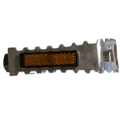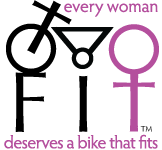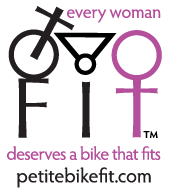 Flat platform pedals that used to come equipped on every bicycle are a thing of the past. The reason? They only allow you to push downward. When you buy a bike that proves you’ve become serious about cycling, you’ll want to maximize your power and efficiency fully with every stroke.
Flat platform pedals that used to come equipped on every bicycle are a thing of the past. The reason? They only allow you to push downward. When you buy a bike that proves you’ve become serious about cycling, you’ll want to maximize your power and efficiency fully with every stroke.
With clipless pedals, your shoe is attached to the pedal (via a cleat), enabling you to “spin” the crank. When one foot comes over the top of the crank, the other foot is pulling backward on the pedal as if you were wiping your foot on a mat. That momentum pulls the foot upward and over the crank, while your other foot begins pushing down. The movement is constant and even, and you can spin the crank faster and work up your road speed without causing excessive muscle fatigue by mashing down on the pedals.
I know it sounds ridiculous to talk about clipping into a clipless pedal. Just know that older pedal systems included a toe clip with a leather harness. These days those pedals are often referred to as “cages.”
Based on ski binding technology, Look developed their clipless pedals in 1984. Since then, other companies have created their own version of the perfect pedal.
If you don’t want to have to worry about clipping in half of the time, get a dual sided pedal. If you have knee problems, I recommend one with ample float allowing your foot to rotate during each stroke without unclipping from the pedal. If you suffer from hot foot you might go with a wider platform. If you want the pedal with the most adjustability, take a look at the more expensive Speedplay models.
It’s a good idea to have your local bike shop install the cleats into your cycling shoes as it can sometimes be a little tricky. Have them also install the pedals and make sure you can clip in and out before you leave the store. If you’re new to clipless pedals, lean up against a wall and clip in and out repeatedly with the foot on the opposite side. Turn the bike around and do the same thing with the other foot. Then take your bike to a grassy area and practice some more. If you fall, the soft ground will be kinder to you than concrete.
Below is a summary of the current pedal/cleat systems available. Though only the entry level system for each manufacturer has been listed, I encourage you to visit the product’s website for more selection. Generally speaking, the lighter the materials used, the more costly the pedal.
| Make | Style | Entry Type | ºFloat | Pedal Weight | Cleat Pattern | Warranty |
|---|---|---|---|---|---|---|
| Speedplay | Light Action | Dual sided | 15º | 210 grams/pair | 3 or 4 hole | limited 2 year |
| Speedplay* | Frog | Dual sided | 26º | 250 grams/pair | 3 or 4 hole | limited 2 year |
| Look | Kéo Easy | Single sided | 0º, 4.5º or 9º depending on cleat | 318 grams/pair | 3 holes | 2 year |
| Shimano** | SPD-A530 | Single sided | 0º | 383 grams/pair | 2 holes | 2 year |
| Shimano*** | PD-M520-L | Dual sided | 0º | grams/pair | 2 holes | 2 year |
| Time | Clic | Single sided | 15º | 260 grams/pair | 3 holes | 2 year |
| Mavic | Sprint | Single sided | 0º, or 7º depending on cleat | 290 grams/pair | 3 holes | 1 year |

